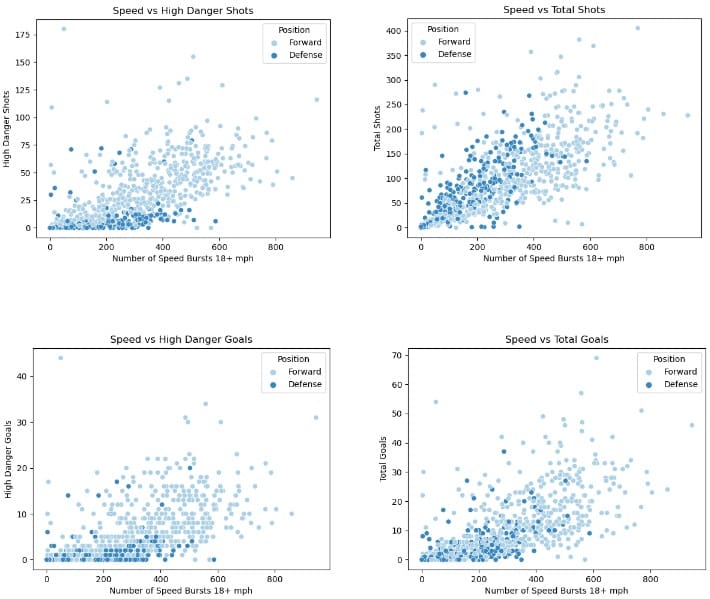NHL EDGE Data Reveals the Link Between Skating Speed and Offensive Success
By Hunter Marriott, MSc
Research and Development Consultant
Speed on the ice comes not only from conditioning, but also from learning the proper techniques to improve your skating efficiency. These skills often come from a dedicated skating coach. Elite hockey players have even gone as far as hiring figure skating coaches to be able to dial in skating fundamentals and improve their edge work. Connor McDavid, regarded as the best skater in the league, has had his success attributed to the “unorthodox” training plan developed by his skills coach. Skating fast and with confidence can be overlooked in favour of stick handling skills and shot techniques, but it is imperative to help improve your game on both ends of the ice.
To investigate if being a great skater is really that important to your overall performance, we used NHL player tracking statistics from the 2023-2024 season, provided by NHL EDGE. Using linear regression modeling, we can mathematically understand which aspects of the game are impacted by skating ability. R2 is the output of a linear regression and ranges from 0, which indicates no correlation, to 1 which is the strongest possible relationship. Anything above R2 = 0.5 is considered strongly correlated.
Over 99% of NHL players were able to reach at least 18 miles per hour (mph) skating speeds at some point last season. The more times a player reaches that speed or higher, the faster a skater they are. To represent skating speed in this analysis, we looked at the number of bursts each player recorded over 18 mph. This is a better indicator of speed than top speed, since some players may only achieve close to their top speed one time. It also better represents acceleration ability since top speed may be recorded over a longer distance rather than ramping up quickly to high speed like in a burst.
Looking at skating speed and shots taken, there is a strong correlation. High danger shots taken from the slot (defined as “The area within 29 feet of the center of the goal and bound on both sides by an imaginary line drawn from the faceoff dot to 2 feet outside the goalpost” by the NHL), have an R2 value of 0.693 when correlated with skating speed. For total shots throughout the season, that value rises to 0.758. When looking at goals, we see a similar story. For high danger goals, there’s an R2 value of 0.656. For total goals, that number climbs to 0.706. What this tells us is that shooting and scoring is absolutely improved with skating ability. The better and faster skaters are getting more shots off, and more dangerous shots. Faster skaters are also scoring more goals, evading defenders to get the best possible opportunities.

Unsurprisingly, in the graphs here we see that forwards have more shots and goals than their defensemen counterparts. That comes with the territory of their position and their roles out on the ice. Interestingly though, skating speed may benefit defensemen more in getting shots off. While both positions have strong correlations to total shots, defenseman edge out the forwards with an R2 value of 0.760 (compared to 0.752 for the forwards). Forwards do have the upper hand in goal scoring though, at R2 = 0.687 whereas defenseman have a slightly weaker correlation at R2 = 0.586.
Filtering skating speeds down a bit, we can look at players who have reached bursts of at least 20 mph, and those who have even gotten to 22 mph or more. When looking at goals scored, it is astonishing the difference between the faster and slower groups. Players that have had at least one burst during the season of 20+ mph averaged 9.08 goals over the season vs only 0.70 goals averaged over the season but those who never reached 20 mph. Narrowing in more, the stats show that players that had at least one 22+ mph burst averaged 12.06 goals in the season, vs 5.24 for those that had no 22+ mph bursts.
It is clear that for all positions, improving your skating ability translates to more shots and more goals, making you a bigger offensive threat on the ice. All signs point to faster skaters having a more positive impact compared to their counterparts that have not reached the same speeds. As we learned from Connor McDavid, skating at a high level is a skill that is easier to achieve through the help of a dedicated coach. So what is stopping you from becoming a better skater, and in turn improving other parts of your game?
References:
